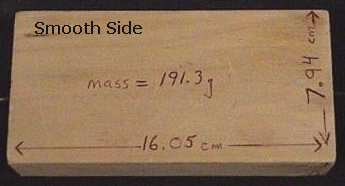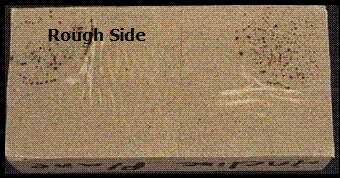How different types of materials can affect frictional forces.
Watch The Video:
Other Demos of Interest:
Teachable Topics:
- Friction
- Forces
- Molecular Interactions
Theory:
It was mentioned in the "Kinetic Friction" page that the kinetic frictional force on a sliding object depends on the following:
- the normal force on the object
- the materials that come into contact between the object and the surface
This experiment will concentrate on the second factor - the type of materials that come into contact. This experiment uses a special block which has one side covered with sandpaper (See Figures 1 & 2). If a force meter is used to drag the block wood-side-down across a wooden board, the meter will register the frictional force that the surface exerts on the block.
If the same block is now turned over, then the materials in contact have changed while the area of contact and the weight (and thus the normal force on the object) have remained the same. Dragging the block across the wooden surface with the force meter again will show that the frictional force has increased.

Figure 1: Wooden block, smooth side up

Figure 2: Wooden block, rough side up
Apparatus:
- Wooden board
- Wooden block with one side covered in sandpaper
- Long piece of string
- Spring scale
Procedure:
- Place the block wood-side-down on the board.
- With a spring scale attached to the block, pull until the block moves and note the force required to do so.
- Now turn the block over so that the sandpaper touches the wood surface.
- Drag the block again and note the amount of force it takes to move it this time.
- Note that it requires more force to drag the sandpaper-covered block than it does to drag the side covered in wood. This is because the wooden side has a lower coefficient of friction.






